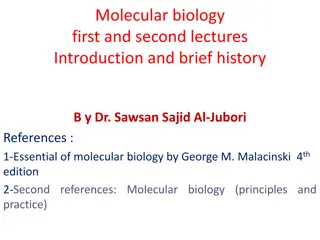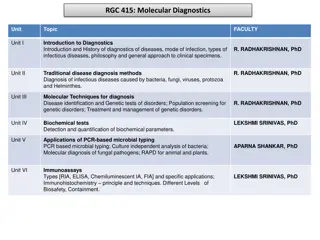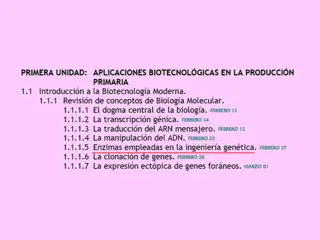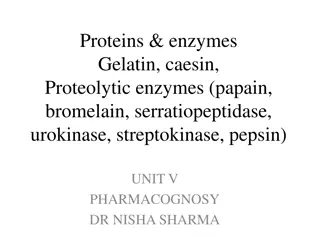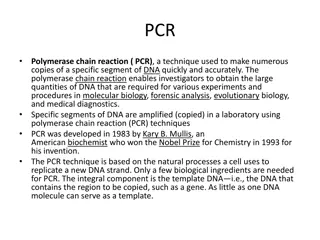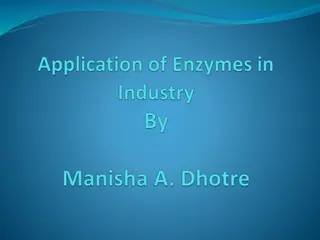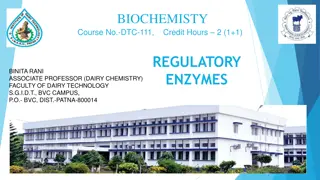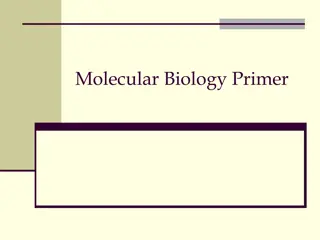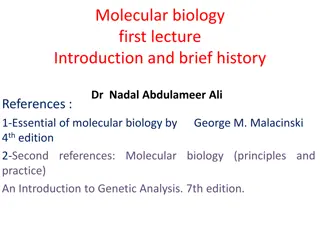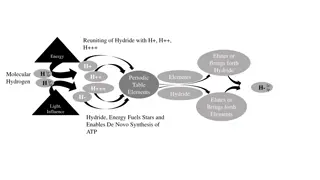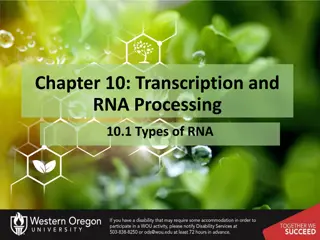Understanding Enzymes and Restriction Enzymes in Molecular Biology
Enzymes are essential proteins that catalyze biochemical reactions. Bacteria have evolved enzymes like restriction endonucleases to protect against foreign DNA, such as viral DNA. The discovery of restriction enzymes in E. coli led to the Nobel Prize in Medicine in 1978. These enzymes cut DNA at specific sites, restricting virus growth. The nomenclature of these enzymes follows a specific scheme based on the source organism. Understanding these enzymes is crucial in molecular biology research.
Download Presentation

Please find below an Image/Link to download the presentation.
The content on the website is provided AS IS for your information and personal use only. It may not be sold, licensed, or shared on other websites without obtaining consent from the author. Download presentation by click this link. If you encounter any issues during the download, it is possible that the publisher has removed the file from their server.
E N D
Presentation Transcript
Topic Enzymes Presented by Prof. Meena Nagawanshi Professor Department of Zoology Deogiri College, Aurangabad
Enzymes Enzymes are proteins biological catalysts help drive biochemical reactions Enzyme names end with an ase (eg., endonuclease) Bacteria have evolved a class of enzymes that destroy foreign DNA (eg. Virus DNA). protect bacteria from bacteriophages (Viruses). Bacteriophages cannot multiply if their DNA is destroyed by the host.
Restriction Enzymes Restriction enzymes were discovered in E.coli as a defense mechanism against bacterial viruses (bacteriophages) They cut double stranded DNA at sequence specific sites 1978 Nobel Prize in Medicine was awarded to Werner Arber, Daniel Nathans and Hamilton Smith for the discovery of restriction endonucleases DNAi Restriction Enzyme
Restriction Endonucleases Restriction endonucleases RESTRICT viruses Viral genome is destroyed upon entry Restriction endonuclease = Restriction enzymes Endo (inside), nuclease (cuts nucleic acid) Restriction endonuclease recognizes a short and specific DNA sequence and cuts it from inside. The specific DNA sequence is called recognition sequence
Discovery 1952-53: Luria and Human discovered the phenomenon of restriction and modification Named as host-induced, or host-controlled, variation.
Bacteriophage Life Cycle http://student.ccbcmd.edu/courses/bio141/l ecguide/unit3/viruses/lytsum.html
Restriction? Bacteriophages varied in their ability to grow on different strains of E.coli. Once growth was achieved on one host strain, the phages could continue to grow happily on this strain. However, the phages were now restricted in their ability to grow on other strains.
Nomenclature Smith and Nathans (1973) proposed enzyme naming scheme three-letter acronym for each enzyme derived from the source organism First letter from genus Next two letters represent species Additional letter or number represent the strain or serotypes For example. the enzyme HindII was isolated from Haemophilus influenzae serotype d.
Few Restriction Enzymes Target sequence (cut at *) 5' -->3' Enzyme Organism from which derived Bam HI Bacillus amyloliquefaciens G* G A T C C Eco RI Escherichia coli RY 13 G* A A T T C Hind III Haemophilus inflenzae Rd A* A G C T T Mbo I Moraxella bovis *G A T C Pst I Providencia stuartii C T G C A * G Sma I Serratia marcescens C C C * G G G Taq I Thermophilus aquaticus T * C G A Xma I Xanthamonas malvacearum C * C C G G G
Classification Synonymous to Restriction Endonuclease Endonuclease: Cut DNA from inside Highly heterogeneous Evolved independently rather than diverging form a common ancestor Broadly classified into four Types
R-M System Restriction-modification (R-M) system Endonuclease activity: cuts foreign DNA at the recognition site Methyltransferase activity: protects host DNA from cleavage by the restriction enzyme. Methyleate one of the bases in each strand Restriction enzyme and its cognate modification system constitute the R-M system
Protection of Self DNA Bacteria protect their self DNA from restriction digestion by methylation of its recognition site. Methylation is adding a methyl group (CH3) to DNA. Restriction enzymes are classified based on recognition sequence and methylation pattern.
Type I Multi-subunit proteins Function as a single protein complex Contain two R (restriction) subunits, two M (methylation) subunits and one S (specificity) subunit Cleave DNA at random length from recognition site
Type III Large enzymes Combination restriction-and-modification Cleave outside of their recognition sequences Require two recognition sequences in opposite orientations within the same DNA molecule No commercial use or availability
Type IV Cleave only modified DNA (methylated, hydroxymethylated and glucosyl-hydroxymethylated bases). Recognition sequences have not been well defined Cleavage takes place ~30 bp away from one of the sites. Sequence similarity suggests many such systems in other bacteria and archaea.
Type II Most useful for gene analysis and cloning More than 3500 REs Recognize 4-8 bp sequences Need Mg 2+ as cofactor Cut in close proximity of the recognition site Homodimers ATP hydrolysis is not required
Recognition Sequences Each restriction enzyme always cuts at the same recognition sequence. Produce the same gel banding pattern (fingerprint) Many restriction sequences are palindromic. For example, 5 GAATTC 3 3 CTTAAG 5 (Read the same in the opposite direction (eg. madam, race car )
Sticky End Cutters Most restriction enzymes make staggered cuts Staggered cuts produce single stranded sticky-ends DNA from different sources can be spliced easily because of sticky-end overhangs. HindIII EcoRI
Blunt End Cutters Some restriction enzymes cut DNA at opposite base They leave blunt ended DNA fragments These are called blunt end cutters AluI HaeIII
Restriction Enzyme Use Discovery of enzymes that cut and paste DNA make genetic engineering possible. Restriction enzyme cuts DNA and generates fragments Ligase joins different DNA fragments DNA fragments from different species can be ligated (joined) to create Recombinant DNA
Cloning Vectors Play Play
Typical Restriction Digest Sterile, deionized water RE 10X Buffer Acetylated BSA, 10 g/ l DNA, 1 g/ l Mix by pipetting, then add: Restriction Enzyme, 10u/ l Final volume 0.2 l 16.3 l 2.0 l 1.0 l 0.5 l 20.0 l
How does it Look after Restriction Digestion? Genomic DNA Digest Plasmid DNA Digest



